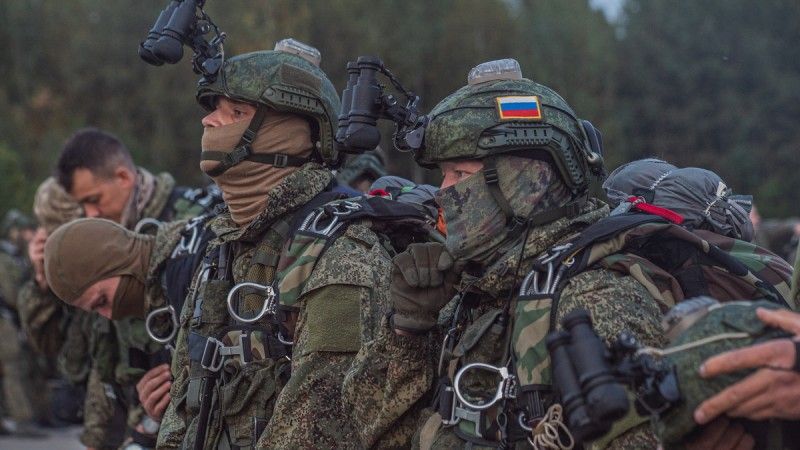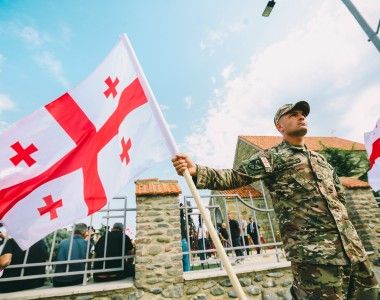Russian Overseas Military Bases

The main enemy to NATO has a considerable amount of military facilities abroad. The Russian infrastructure in foreign territories includes airports, bases, proving grounds, radar stations and navy installations. The process of expanding the military potential has begun in the previous century but strategic investments and contract extensions are being undertaken nowadays. The Russian Federation is aware that global rivalry is unlimited and that the key to maintaining the status of a world power is constant, intensive and unconventional use of influence in several regions at the same time, for instance Eastern Europe, Central Europe and Northern Africa.
Military facilities abroad are an element of international competition and a manifestation of superpower ambitions. It is also a proof that the country still takes part in the global game, not staying behind the USA, France, China, Great Britian and Turkey. The Russian Federation is trying to maintain its influence in the former U.S.S.R. territories and is constantly seeking opportunities to increase its military potential in Asia and Africa, which would enable the development of cooperation with countries in these regions — not only of a military, but also political and economic nature.
Read more
The Russian Federation has many bases around the borders of its territory. Some of them are the effect of the strong ties between post-soviet countries and others were created artificially: firstly, by conquering a part of other independent state (for instance Georgia); secondly, as a form of bilateral agreement (i.e. Syria).
Georgia
The Russian 7th Military Base in Gudauta has a long history. After the dissolution of the U.S.S.R., the former Soviet airbase at Bambor Airport was transformed into the Russian 7th Military Base and was one of four Russian military bases in Georgia (others were located in Akhalkalaki, Batumi and Waziani near Tbilisi). At the 1999 Istanbul summit of the Organization for Security and Cooperation in Europe (OSCE), Russia agreed to close all 4 bases, including those in Waziani and Gudauta, by 2001. After the change of president of Russia, Russian authorities decided that the Gudauta base would be transformed into a training center for the Russian peacekeeping forces of the Commonwealth of Independent States stationed in Abkhazia. The bases became the subject of a dispute between Georgia and Russia, as the Kremlin did not meet the deadlines and extended the stay of its troops in Georgia.
Read more
The 4th Guards Military Base in South Ossetia, along with the relevant infrastructure, was established on February 1, 2009 (after the end of the 2008 war, until which peacekeepers composed of Ossetians, Russians and Georgians were stationed in the territory of South Ossetia and the entire operation was monitored by an OSCE mission) by the Russians who were the first to recognize the independence of South Ossetia in order to stabilize the situation in the region. The period of military cooperation between the Russian Federation and South Ossetia was initially set at 49 years, with the possibility of extending it for consecutive 15-year periods. Russian military posts are located in almost immediate vicinity of the Batumi – Tbilisi – Baku land route which runs between Azerbaijan and Turkey. About 5,000 Russian soldiers are stationed in the base.
Armenia
The base (Russian 102nd Order of Alexander Nevsky Military Base, the Southern Military District) is a part of the Group of the Russian Forces in Transcaucasia. It is also a part of the United Forces Group of the Armed Forces of Armenia and the Armed Forces of the Russian Federation. Currently, in its history, the base refers to the Soviet unit, formed during World War II. In its contemporary form the base has existed since September 1, 1994 when it was formed in lieu of the 127th Motor Rifle Division. The last organizational change was the inclusion of the 73rd Separate Motor Rifle Brigade on April 1, 2010. In addition, The unit also includes 3 military training grounds: Nubarashen (25-30 km from Yerevan), Kamhud (15-17 km from Gyumri) and Alagyaz (10-15 km from Artik).
Read more
The declared goals of the base are: ensuring the security of Armenia and Russia as members of the CSTO by preventing threats from the southern direction, fulfilling the duties of the containment doctrine, performing combat duty as part of the CIS air defense and cooperation with border units of the Federal Security Service of the Russian Federation stationed in Armenia. Russia does not have a land border with Armenia so majority of the deliveries to the base are made by air. For this reason, its potential lies not so much in military power as in a political sense. According to the bilateral agreements, Russian units in Armenia are obliged to support the Armenian armed forces in the event of direct aggression, which would mean joining an armed conflict by the Russian Federation.
Kazakhstan
There are 3 military bases. Sary Shagan anti-ballistic missile testing range is a test site for the development and testing of armaments, anti-missile weapons and anti-aircraft weapons. Base is located northwest of Lake Balkhash in the desert highland of Betpakdala in the Karaganda Oblast and in the Jambyl Oblast. Its construction began in 1956, and the main criteria for choosing this location were flat and thinly inhabited terrain. Russia has leased the Sary Shagan Test Site since 1996 to develop and test its missiles. The rockets are fired from the Kapustin Yar proving ground in the Astrakhan Oblast, Russia. So far, approx. 400 anti-missile launches, approx. 5,500 anti-aircraft guided missile launches and more than 900 ballistic missile tests.
Read more
The second base is the Baikonur Cosmodrome; space flight center. Official work began on June 2, 1955 but the first attempt took place on August 21, 1957, when the R-7 ballistic missile was launched, reaching a distance of 6,000 kilometers on the Kamchatka Peninsula. Six weeks later, on October 4, 1957, a modified R-7 put the first artificial Earth satellite, Sputnik-1, into orbit. On April 12, 1961, the first human, Yuri Gagarin, was launched in the Vostok 3KA spaceship from Baikonur. Russia has the exclusive lease of Baikonur since 1994, paying USD 115-million rent every year. Russia also transfers approximately USD 38.5 million annually to a nearby city.
The third base is the 929th Valery Pavlovich Chkalov State Test Flight Center, Taysoygan. It is the main aviation research institution of the Russian Federation Air Force. Military aviation equipment and aviation weapons are tested, including airplanes and their equipment and armaments, ground service, air facilities and unmanned aerial vehicles. Particular ships undergo special checks here. The 929th Center uses airports, training grounds, specialized laboratories and runs climatic and mechanical research, among others. Every year, over 220 independent tests are performed, at least 1,600 flights and over 70 research projects are carried out. The fourth base – Balkhash Radar Station – that provided coverage of western and central China, India, Pakistan was closed on 1 June 2020.
Kyrgyzstan
There are 4 Russian facilities in the Kyrgyz Republic. Kant Airbase, the Russian 5th Air and 999th Air Defense Forces Army Base, has been a Russian military base since 2003. It was leased on the basis of an agreement signed by the leaders of both countries, initially for 15 years; then the agreement was extended. Before establishing the base, the area and buildings of the airport served as a pilot and aviation personnel school for years. Nearly 300 Russian soldiers and local civilian personnel are stationed at the base.
The 954th Anti-Submarine Weapons Test Base of the Russian Navy, "Lake" is located in the immediate vicinity of the city of Karakol, on the Przhevalsky Bay, in a mountainous area, 1609 m above sea level. The base was established as early as 1943, although the official starting date is August 24, 1955 when the U.S.S.R. flag was raised over the base. Currently, the military base operates on the basis of bilateral agreements of the Kyrgyz Republic with the Russian Federation. The Russians stationed at the base use the water of the nearby lake for exercises with the use of sea mines, self-propelled underwater warheads, depth bombs and underwater vehicles.
Read more
338th Naval Communications Facility "Marevo" / "Prometheus" station is located in the village of Pervomaj, near the Ashmara River (Kyrgyz: Ашмара), at the Kyrgyzstan-Kazakhstan border. Its construction began in 1974, while it was launched as a base under an agreement signed by representatives of Russia and Kyrgyzstan in 1993. The value of Prometheus is estimated at USD 4.5 million. Russians do not pay the Kyrgyz government lease payments, but in return they provide the Kyrgyz people with weapons, conduct military training and renovate the necessary equipment.
17th Radio-Seismic Laboratory of the seismographic service of the Ministry of Defense of the Russian Federation is located in the Tian Shan mountain range in the town of Mailuu-Suu. Its employees control nuclear weapons testing, using, among others, the Chinese proving ground located in the dry Lop Nor Lake. Research is also being carried out on tectonic plate movements and seismic hazards.
Transnistria
In the territory of Moldova, which is currently controlled by Transnistrian troops, there are units that once constituted the 14th Army of the U.S.S.R. Currently, the remaining Russian group of about 1,500 soldiers controls large stockpiles of Soviet weapons. The core of the Russian contingent in Transnistria — the so-called Operational Group of Russian Forces in Transnistria — is formed on the basis of the former 14th Army. The number of OGRW contract soldiers is probably at least 1,200-1,500 (2 or 3 battalions). The Ukrainian side estimated in June that a Russian combat group of about 3,500 soldiers was stationed in Transnistria.
The conflict in Ukraine caused that the separatist republic of Transnistria is no longer seen only as a potential hotspot in Europe, but also as a Russian stronghold behind Ukrainian lines. The potential of the armed forces of the separatist republic is estimated at approximately 7,000 soldiers of various formations.

Syria
Hmeimim Airbase is a Syrian airbase currently used by Russians. It is located close to the Latakia Airport, in the west of the country, at the coast of the Mediterranean Sea. The legal status of the base is regulated by the treaty signed by Russia and Syria in August 2015. In late 2017, Russia decided to transform the Hmeimim base into a part of its permanent military contingent stationed in Syria. The base is protected against enemy air strikes by the Russian S-400 and Pantsir-S1 missile systems. Russian multirole fighters are stationed there, including Su-35, Su-33 and MiG-29.
The 720th Logistics Support Point of the Russian Navy in Tartus is located at the coast of the Mediterranean Sea, approximately 25 km north of the Syria-Lebanon border. The port is of significant importance due to the turbulent situation in the region. It strengthens the Russian position and influence in the Middle East. Furthermore, it enables the Russians to make strategic movements in the Mediterranean Sea, which may be of key importance in the event of an outbreak of a conflict in Africa or a need for a rapid deployment of troops.
Apart from the two military bases that are leased and fully used by the Russians, mention should be made of Syrian military airports, which have also been occasionally used by Russian troops since 2015 — these are al-Shayrat Airbase and the Tiyas Military Airbase. Both airports are located in the neighborhood of the city of Homs. The Aviation Group of the Aerospace Forces of the Russian Federation uses bases as transit points. Both bases continue to function as Syrian and Russian airports.
Tajikistan
The Russian 201st Military Base was deployed in Tajikistan after the reorganization of the 201st Motor Rifle Division which in the 1990s, together with Russian frontier guards, defended the Tajikistan-Afghanistan border. Negotiations on the further lease of military bases started in 2008. The previous contract, signed in 1993, expired after 20 years, in the first half of 2014. Tajikistan called for shortening the time of another agreement to 10 years and introducing a rent of USD 250 million a year. The result, however, is the opposite — the period of the ratified agreement is 30 years. It is the largest Russian military base in terms of manpower.
The "Okno" ("Window") Optical Electronic System for Space Monitoring is an optical-electronic complex worth USD 242.4 million, which tracks the movements of satellites. It is situated at an altitude of 2,200 meters above sea level in the Pamir mountain range, near the town of Norak. The location of the "Okno" was selected taking into account the properties of the atmosphere (optical transparency and stability) and the number of bright night hours (approx. 1500 hours per year). The "Okno" provides information about detected objects, classifies them, is able to distinguish human satellites from natural meteorites and rocks floating in the aerospace, calculates trajectories.
Planned military bases in Africa
Due to the maintained influence or intensified cooperation on the military and political level, the bases and troops that the Russian Federation had in the past or intends to create should also be distinguished. It is connected with a return to selected countries or only with a planned military engagement. The attempt to rebuild Russia's potential in Vietnam, the intensification of relations with Serbia and the increased presence in Africa are particularly noteworthy. One cannot forget about using Crimea which is a strategic point for operations in the Black Sea.
It is highly probable that in the future the Russian Federation could establish its bases or use the territories of Egypt, Eritrea, Mali, Burkina Faso, the Central African Republic, Somalia and Sudan for its military purposes. In addition, recently the Russian Minister of defense Sergey Shoigu names the list of states from Africa that are friendly to Russia: Burundi, Republic of Guinea, Cameroon, Mali, Sudan, Uganda, Chad, Ethiopia, the Republic of South Africa.
Russian bases as a challenge for NATO
The idea of developing Russian facilities abroad seems to be accurate in the perspective of a long-term competition. The scenario in which other countries decide to join particular alliances or form bilateral agreements is realistic. Thus, the Russian Federation takes a step forward in order not only to maintain its current authority, but also to extend its capacities by engaging in several continents. The result of these activities will be a good position of the Kremlin in international negotiations and further contracts, on both the military and economic level. Such tactics, provided that Moscow has enough potency and resources, will be crucial for its interests in Europe, Asia and Africa, and thus will be closely watched not only by European Union and NATO states, but also by those actors who decide to cooperate with the Russian Federation in the future.
The Russian foreign bases in Belarus were not taken into account. The cooperation between two states is very strong as well as the Moscow's irrefutable influence on Minsk. In addition, it is worth mentioning the Russian involvement in Serbia, Vietnam, as well as, aggression on Ukraine.
The already existing network of Russian bases (particularly those in Syria and the Crimea) poses a serious challenge to NATO for at least several reasons. It can create a serious obstacle to exercises and naval operations carried out by NATO as well as to possible future stabilizing and peacekeeping operations. Moreover, the increasing Russian potential in the southern strategic direction must be included in NATO's operational and defense planning. Currently, the Alliance is mostly concentrated on Ukraine. However, Russia will try to use their military forces as well as Wagner Group to harm NATO countries (for instance, the activity in Mali and the end of French mission Barkhane). NATO must observe Russia on the worldwide level. The case of Ukraine could be used to distract the Alliance. NATO must operate globally and follow all sordid activity carried out by Russians.








